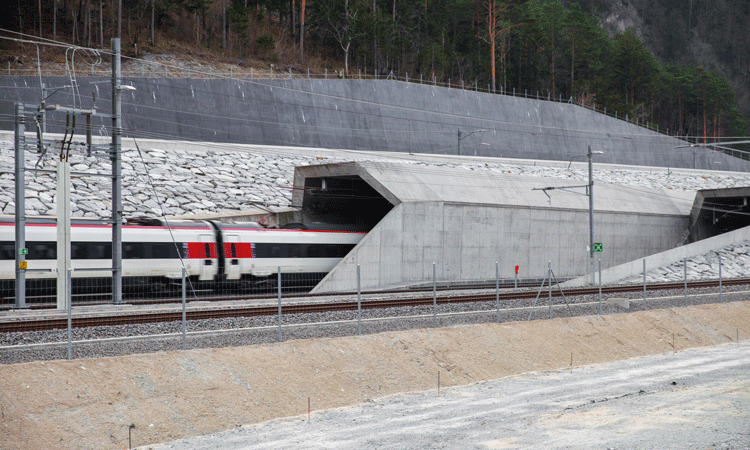From road to rail: A pan-European challenge…
Posted: 25 July 2016 | Jörg Leichtfried (Austrian Federal Minister for Transport - Innovation and Technology) | No comments yet
After 17 years of construction and building costs totalling almost €11 billion, the big day finally arrived at the beginning of June 2016: the inauguration of the 57km-long Gotthard Base Tunnel in Switzerland which attracted much international attention highlighting the European dimension of centennial projects of this kind. Together with the Ceneri Tunnel still under construction and other projects in Italy, the tunnel has a key role within the European TEN-T core network. It once again showcases the relevance of international cooperation with neighbouring countries – in this case, Gemany and Italy – for a corridor’s capacity and long-term perspectives. The much reduced travel time and the gains in efficiency promise impetus for combined cargo transport via the corridor from Rotterdam to Genova.


In Austria the Brenner Base Tunnel is of similar importance: once completed it will replace the Gotthard Tunnel as the world’s longest railway tunnel. The further development of the railway networks – in particular key construction projects along the European corridors – guarantee Austrian businesses efficient connections to European maritime ports. This allows us to compensate for the disadvantages of being a land-locked country and permits Austria’s industries, such as the automotive sector, to partake in the European value creation chain.
These cross-border mega projects also require us to identify joint operational concepts and regulations with our neighbouring countries as the only way to render rail transport more efficient and increase its share in total transport volumes in the medium-term.
Why do we want this?
The ambitious climate goals set out in the Paris Agreement, the EU objectives, and the White Paper on Transport impose a clear reduction in climate damaging emissions – including from that of transport. These goals can only be achieved if we keep driving the shift of cargo transport from road to rail and creating the respective political framework conditions. More cargo transport by rail equals fewer emissions.
In Austrian cargo transport the ‘modal split’ currently totals approximately 30% which is already higher than the European average. Our target in the national overall transport scheme, however, is a shift of 40%. Various challenges still need to be overcome in order to reach this target.
Even though rail cargo transport concepts predominantly cover long distances, too many obstacles for cross-border transport still remain. In European fora Austria advocates an elimination of these barriers. During the ‘TEN-T Days’ in Rotterdam, several countries including Austria signed a Memorandum of Understanding to reduce waiting times at borders for cargo trains. The technical pillar of the 4th Railway Package defines the harmonisation of operating instructions as a central task for increasing efficiency. Uniform operating instructions throughout the whole operating territory are also important for the ‘European Rail Traffic Management System’ which exists to regulate the traffic in the European core network.
Access to rail capacities in the European core network must also become much more flexible in the future, in order to be able to quickly respond to market needs. At present access to train paths generally requires a long lead time. Strengthening rail throughout Europe requires a comprehensive approach that includes infrastructure, terminals, and offers for the ‘last mile’ in cargo transport.
What is needed is a combination of both large and small-scale solutions
After all, we must also look beyond Europe’s borders. Rail is important for intercontinental cargo transport; let us think of connections with the direct neighbouring countries, as well as those of Russia and China. At present rail is particularly relevant for linking ports to the hinterland. The transcontinental railway links offer the potential of generally quicker links than in maritime transport. China has launched an initiative for a ‘new silk road’. Plans also exist for Russian broad gauge to be extended into the Vienna region. Even though Russian broad gauge is not compatible with the European core network, and thus cannot be integrated, an intelligent and efficient link between the two systems in a high-potential ‘hub-region’ such as Austria could provide an important boost for the European economy.
At a national level the Austrian Federal Ministry for Transport, Innovation and Technology subsidises rail cargo transport with an annual €100 million. A reform of the current subsidy scheme will shift another 100,000 annual truck trips to rail. We now increasingly subsidise partial legs from the company to transport nodes. A greater focus on the cost structure of single wagon traffic and short-distance transports allows us to achieve three times the volume at the same cost.
Finally, fair competition between the transport modes is needed to encourage further shift to rail. While cargo trains are charged for every single kilometre covered, this is not the case for all trucks on all roads. Therefore, true-cost pricing in transport is something we should also address at European level.







